#Rene Magritte Early works
Text

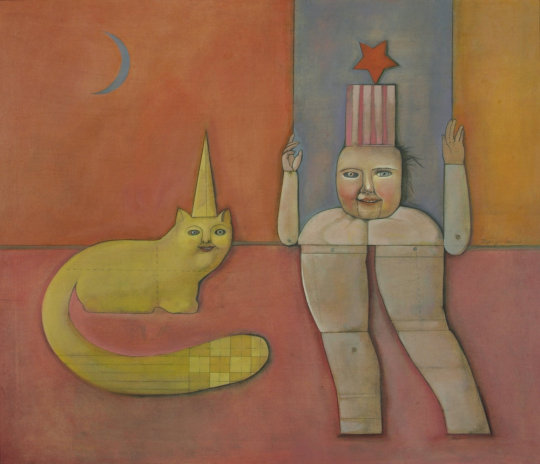

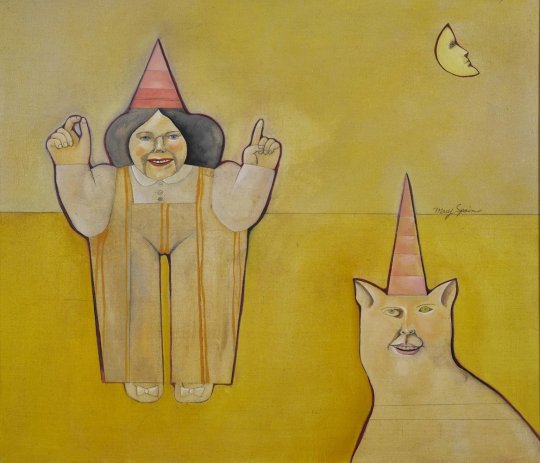


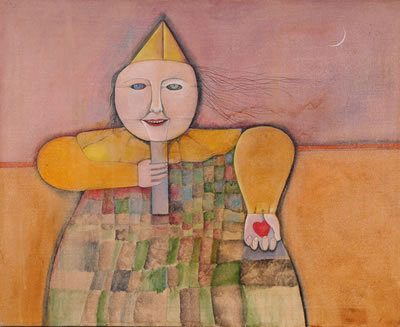
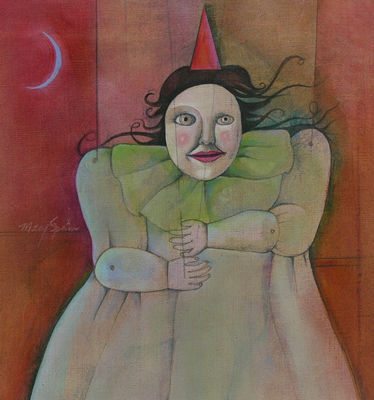
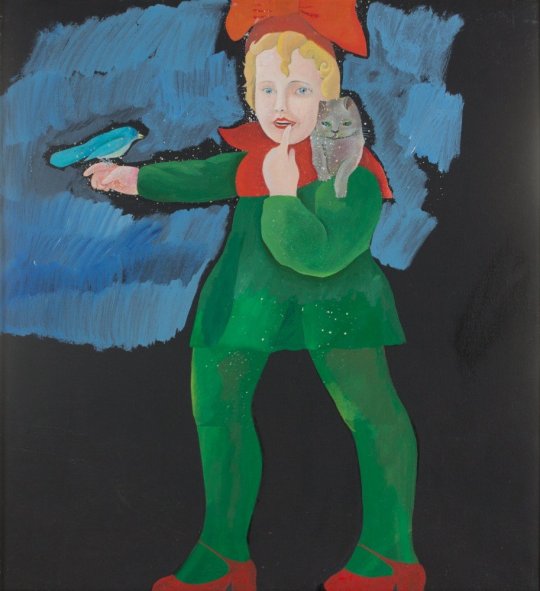
MARY SPAIN
American, 1934–1983
"As a small girl, Lisa Eastman lived across the lane from a magical woman who moved effortlessly across sun-dappled wood floors, under cathedral ceilings and surrounded by large colorful paintings. The smell of oil paints filled the air, casting a powerful spell on the younger girl. “That’s when I knew I wanted to be a painter.” Mary Spain Colie had spread her magical life to another generation, though her own life ended before middle age.
The details of Mary Spain’s life are sketchy, drawn more in paint and sculpture than biographical details. She grew up in North Carolina, but shared a creative soul with famed Belgian artist, Rene Magritte whose work pulled her away from the Expressionist landscapes that defined her early career. Later she moved to Ohio to teach art at Chagrin Falls High School and lived a quiet life with her husband Frederic Colie, a fireman, outdoorsman, and commercial chemicals salesman.
The parallels between their lives and works are hard to ignore. Putting Magritte’s renowned “Son of Man,” beside any of Mary Spain’s many masked figures makes one question the effects of having a world war take place in your back yard or childhood. Magritte’s response was to probe deeper and deeper into Surrealism, a style that challenged viewers perceptions of reality. He became one of only a handful of surrealistic masters.
Mary Spain, on the other hand, escaped to her magical kingdom on the banks of the Chagrin River. There she captured a world others couldn’t see in surrealistic images of people and animals, often mechanical, always mysteriously hidden behind masked faces. Certainly they were influenced by her collection of antique dolls, but where did her love of dolls and whimsical images come from? One art critic wrote: “Exactly when Mary Spain tumbled into her pictorial Looking-Glass world is difficult to determine. She may have been born there.” Only Mary Spain Colie knew for sure, and her voice was silenced by cancer at the young age of 49. Magritte lived two decades longer, but succumbed too early to the same horrible disease.
Her husband, Frederic, had supported his wife’s career by forging relationships with galleries in Cleveland, New York and Florida. After her death he withdrew all her paintings and sculptures from those galleries. They were never again offered for sale until after his own death in 2012."
https://wolfsgallery.com/.../mary-spain-girl-tossing...
44 notes
·
View notes
Text
It's a Sin | Secondo/Papa Emeritus II x Female Reader (NSFW)

(A/N: First Ghost fanfic! Uploaded to Ao3 first, but figured I'd give Tumblr a spin too. Image is by Rene Magritte: "The Lovers II", 1928. Getting into the habit of fanfic again; it's been ten years.)
Content: Secondo x Female Reader ; Fluff ; Pillow-talk ; Implied Sexual Content ; Heavy Petting ; Relationship insecurities talk
WC: ~1500 words
You've been involved with Papa Emeritus II for a while, but it's never gone beyond physical affections and romantic professions. The inevitable consequence of such is a confrontation of these emotions, and whether it means much to this grandiose figure of Satanic desire.
---------
Tangled in sheets and limbs, you recover from another wave of ecstasy. The sensation has near brought you to tears more than once, bliss mixing with an overwhelming release. Secondo holds you close— he always has a hand on you somewhere or somehow— and the smirk he wears after making you orgasm never gets old. His Papa makeup is smeared, fine tan skin appearing beneath the swipes of white paint and black detail. You can see a bit of your lipstick, a sharp red in contrast, painting his lips a puckered pink. You know that you probably look just as disheveled.
A small price to pay for delight.
The sight from the hotel room is a beautiful one, with Paris’s landscape slinking out from the morning fog. It had to be the early morning, somewhere past midnight, and the twinkling lights of a dark city peppered the room with gentle lighting. Secondo had stumbled back in a few hours ago, somewhat intoxicated, still dressed in his papal robes. When he’d seen you he’d lost all his composure, something limited from the post Ritual high anyway, and hadn’t let his hands leave your body since.
As you adjust a little in bed, Secondo looks over at you. His proud, hooked nose casts a pretty shadow over his cheek, making him somehow look younger and sweeter. It’s moments like these you take advantage of seeing another side of Papa Emeritus II. While the crowds go wild, and the women beg for a taste of him, you know that it’s your bed that he returns to every night. Scents of musky sex often perfume his body, but you know that sexual urges are a divine right by Lucifer. To abstain would be an insult, and far from the practices of the Clergy and what they expect of their members… and their Papa.
You aren’t a Sister yourself, though you have thought about joining. There is nothing against fraternization within the Clergy, not that you know of or that Secondo has told you, but part of you hopes to keep the distance between his work and… You.
It was hard to feel special at first, or really like you were anything other than another lay, another groupie. Secondo made it clear quickly, however, that you were special. He was never one to play games, not with those hardened eyes. Yet it would be doubt that plagued every post coitus session, despite all the smiles and how sweetly he’d finger you, that things were simply convenient for him.
“What plagues you, cara?” He asks suddenly, and while you were lost in thought you catch that he’s been looking at you the whole time, silently, with that smirk having fallen so slightly. His gaze traces your form, catching on your lips and your breasts more than once. “You reached climax, no? Tell me I have not failed you— ”
He smiles again, quick to carry on, “— of course not, you look as if you’ve been kissed by Lucifer himself. The blush on your cheeks and your chest… You are beautiful.”
It makes you smile too, but you know that he was right to ask if everything was alright. Your elation was evident, sure, but there were those moments of silence that seemed to catch your nerves. He has only spoken up once or twice about it, but you were quick to dash his concerns.
Now, it seems, he wishes to know more. The tactic of flirtation is a clever, usual one from him.
“It’s just…” The words struggle to fall from your lips, and your turn fully to face him. You reach up to caress his jawline, your fingers trailing from neck down to the bed and falling with a thump. “It’s stupid. I feel… Jealous, really.”
This makes his eyebrows raise. He struggles to adjust himself, the sweat laden sheet falling from his chest and relaxing around his hips. He sits up, staring down at you.
“Jealous?” Secondo repeats with his hardened stare. He appears angry, a superficial observation of the man, but you know that it’s just the way his brow tends to furrow in concentration. You give an exasperated sigh, a scarlet flush of shame riding on your cheeks. You sit up as well, holding the sheet to your chest, feeling far too exposed in more ways than one.
“I dunno,” you mumble at first. It’s hard to admit, but you give yourself credit for getting this far. “Jealous… maybe isn’t the word. It’s just that… Remember how I said I was considering joining the abbey? Becoming a Sister? Being able to… join you often, and to worship Satan with the others?”
He nods, slow at first as his memory rushes to catch up.
“I haven’t gone about it yet… and I don’t know if I will. You fuck beautiful women, you sing, you are this… laviscious figure of worship and devotion and it doesn’t bother me as much anymore. Yet I… I dunno, maybe… I’m afraid of being left behind?” The words squeak out of you, your fingers clutching onto the bed sheet.
“Of being just… just another woman you leave behind. You tour the world, Secondo… You bring so much joy to people. You bring joy to me... I just don’t want to be the one to hold you back. To keep you behind.”
He remains quiet, staring and listening intently. For a second you’re sure that he’s forgotten how to speak— it’s the only other conclusion for a man who seems to always say the right thing— or, perhaps, you’ve offended him by trying to remain oh-so important. The burden of duty weighs upon the crown of many who lead, this you know… And it is far more of a dedication than one simple relationship. Your relationship. For months now you’ve felt this way, ignoring it with sex and laughter, and only now has the nerve finally come to say something.
Yet, you’re afraid now. You don’t want to lose him.
Finally Secondo looks at you, and grabs at one of your hands. He kisses the palm lightly, trailing featherlight touches from your wrist to your forearm. He returns his kiss to your hand, holding it close against the curve of his cheek.
There it is again, that glimpse of a younger, more vulnerable man. It feels like a trick of the light, or maybe your own hope that he was different with you.
“Cara. I am not a man who squanders the gifts I have been given. For all that I have… and all that I must do… It does not come second to what I want.”
He draws you close, and you fall forward into his arms. They wrap around you, a warm embrace as he kisses the top of your head. You shudder into the closeness, intimacy filling you and sealing battered wounds.
“I would not be here if you were simply someone to me, another body to worship before moving onto the next. You… you remind me, cara, that beneath the paint and the robes there is still a man. They see Papa. You see… Secondo.”
His words ring true, lighting your insides with a carnal fire. Pulling back slightly you look up at him, in time to feel your own eyes sting warm with tears.
“Do you mean that?” You ask, your hands clutching at him.
His hand snakes around your waist, and his nails dig into your flesh enough to make you shudder again. “I do not lie. I crave pleasure as much as I wish to give it. And you are the one that I wish to give it to. On my own time. When I am just a man, naked and bare in front of you.”
You feel the magnetic pull between you two, the same thing that had drawn you to him in the first place, and it clears the distance between your lips. They find his lips, and it’s a kiss that ignites your core. He kisses fervently, perhaps to prove the point, and pulls you even closer.
Before you know it you’ve tumbled back onto the bed, half on top and half sprawled next to him. Secondo swipes his thumb over your cheek, and a wicked grin splits his mouth.
“Now you must stop this crying, these tears, these worries. Or I will have to make you come again, and again, and again—”
It makes you laugh. You kiss him again on the corner of the mouth, and he utters a little groan, grabbing onto you tighter once more.
“You better. You said you don’t lie,” you say with a tease, letting your hand twirl circles onto his chest.
With that he rolls you over with a hearty laugh, his hungry kiss descending your fears to delicious, sinful paradise.
#papa emeritus ii#papa emeritus ii x reader#papa emeritus ii x female reader#smut#fluff#ghost fanfiction#papa emeritus fanfiction#original fiction#the band ghost#ghost fanfic#ghost bc fanfic
103 notes
·
View notes
Text
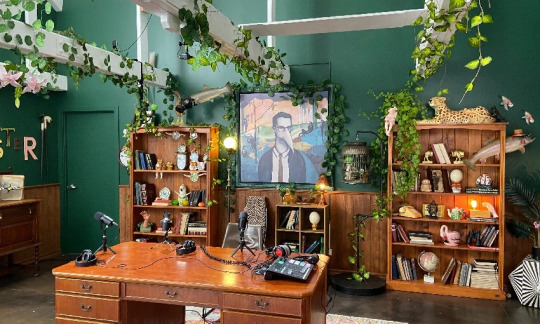
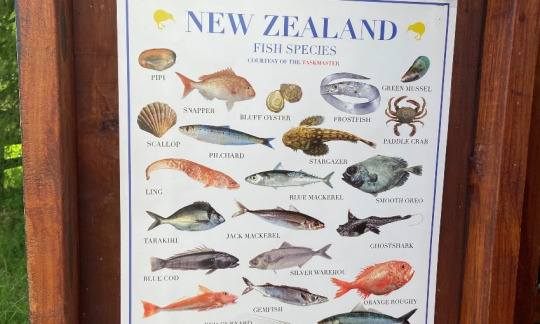

A strange, strange morning at the Taskmaster NZ house
Stewart Sowman-Lund gains access to the north Auckland mansion where the TVNZ comedy gameshow is filmed and uncovers the secrets the cameras don’t see.
After four years, the Taskmaster house is a cast member in its own right. The mysterious and ever-evolving setting for the TVNZ comedy show is ostensibly just a house north of Auckland. But for fans of Taskmaster, it’s a memorial to the show itself. Hey look, there are the rafters that David Correos climbed into, in what was probably a health and safety breach. There’s the bar where Leigh Hart attempted to use a leaf blower to make a cocktail. And I think that’s where Urzila Carlson drank a lot of scotch while playing hopscotch?
Returning tonight, season four of Taskmaster NZ sees five new famous faces vying to win a gold bust of Jeremy Wells’ head: Dai Henwood, Mel Bracewell, Ray O’Leary, Karen O’Leary and Sieni Leo’o Olo (aka Bubbah). You’d probably expect that after three seasons, the incoming cast of comedians would be well-versed on how Taskmaster works. But as I found out on a visit to the Taskmaster set back in March, that might not be the case.
It’s a few weeks after Cyclone Gabrielle when I pull up outside the Taskmaster house and am greeted by Paul Williams. In the world of the show, Williams is the Taskmaster’s assistant, a meek and slightly awkward character whose entire purpose is to do whatever it is the Taskmaster, Jeremy Wells, demands. Largely, that means guiding the contestants through the absurd challenges they find written in wax-sealed envelopes. “They all really like me,” Williams says sarcastically of his relationship with the contestants. “I don’t annoy them at all.” (Karen O’Leary later describes Williams to me as “a bit of a dick”, though reluctantly admits that he could be helpful during some tasks.).
In real life, Williams doesn’t seem that far removed from the character he plays on the show, leading me to question whether he’s still in character while showing me around the Taskmaster house. We start our tour upstairs in the study, this season made over with dark green paint and jungle-like vines hanging from the rafters. Behind the desk hangs a Rene Magritte-esque painting of Jeremy Wells with a long bird’s beak.
The bookshelves have also been packed with an assortment of loosely-themed objects, including a cheetah, a pair of binoculars and a globe. Books about travel and exploration are stacked up too. To the side of the study, just out of shot from the cameras, Williams points out a curtain that conceals an assortment of extra props, like a spare print of the Wells bird painting made “in case the comedians damage the one on the wall”. Given this is Taskmaster, you really do need to prepare for everything.
The study leads through to a small bedroom that Williams, with the awkwardness of a teenage boy apologising for not cleaning up, admits is his. Occasionally he sleeps over in the Taskmaster house so as to avoid an early morning commute to set. Piled up in a drawer next to the bed are artefacts from previous Taskmaster seasons that should really be collected and donated to some sort of Taskmaster museum. The pile includes draft lyrics from a Guy Montgomery musical task in season two and a piece of paper with some frantic scrawling that could only belong to David Correos.
Downstairs, we stop at a washing machine. I’m not sure it’s meant to be part of the tour until Williams grabs out a solitary pair of sodden black socks, which he proceeds to carry around with him until remembering they need to dry.
We head out towards the dock, a small wharf that overlooks a swampy green pond, and the setting for a number of water-based tasks. It’s a surprising distance from the main house and along the way, Williams points out several iconic locations from the show. There’s a life-sized lion sculpture, replacing the cow featured in previous seasons (“the cow’s on loan, I think,” says Williams). We pop into the shed and see the fish poster made internationally famous by Rose Matafeo on Taskmaster UK stuck to the inside of the door. There’s the bathtub used for the infuriating final task of season three: “Relocate the water in this bath to that bath”. We pass through the “enchanted forest” and I’m uncomfortably reminded of Paul Ego’s sex witch.
All the while, Williams is carrying his all-important iPad (and the socks) which reminds me of a question I’ve always had for the Taskmaster assistant, one that has perplexed Reddit for years. “Can you tell me once and for all if the iPad actually controls anything, or if it’s just a prop?” I ask Williams, who looks at me coyly: “I cannot disclose the secrets of the iPad.”
Later, after Williams has been called back for some filming, I’m standing in a gazebo on the back lawn about to watch a team task involving Dai Henwood, Karen O’Leary and Bubbah. They’ve been instructed to weave their way, blindfolded, through a maze. I’m told the task should only take about 10 minutes, but nearly an hour later we’re still standing there watching the trio of comics flounder as they try to complete it. There’s talk of breaking early for lunch, but the contestants are determined to finish the task no matter how long it takes. A crew member tells me that quite often the team tasks don’t make it to air, but this one definitely will. Why? Because “the other team [Mel Bracewell and Ray O’Leary] did it on their first go”.
It’s part of the joy of Taskmaster that being really bad at a task is often as impressive as being really good at it. For Wells as Taskmaster, that means his job is often determining whether to give points to the best contestant – or the funniest. Bubbah tells me she’d never even heard of the show before being cast, let alone how it works, and that means her performance in the season hasn’t been tampered by any thought of actually winning points. “It was like halfway in when Paul was like ‘what do you think the Taskmaster’s gonna say’? I was like ‘Who the fuck is the Taskmaster’?” she says. “Obviously I have not been thinking about how he’s going to react.”
Henwood also went in largely blind, though at least he actually knew what the show was. He was originally set to appear in season one of Taskmaster NZ, but ultimately had to wait another three years before being cast. “I went ‘I don’t want to watch it’ because I didn’t want to be influenced’. I purposefully kept myself in the dark and now I’m going to binge watch the old ones and go ‘I should have prepped for this’,” he laughs. Karen O’Leary was perhaps the most prepared – but she was hardly a diehard Taskmaster fan. She’d watched snippets from previous seasons and admits to trying to appeal to Wells’s ego in her performance. “I think he’s someone who is quite pedantic… My aim is to try and find my own exception to what the tasks are by mucking with how they have been worded,” she says. “I’m sure Jeremy will understand, but time will tell.”
#taskmaster nz#taskmaster#paul williams#jeremy wells#mel bracewell#ray o'leary#dai henwood#karen o'leary#bubbah#guy montgomery#david correos
30 notes
·
View notes
Text
Evelyne Axell
Evelyne Axell was a Belgian pop artist known for her politically charged erotic paintings that transcended the boundaries of what was her socio-political reality.
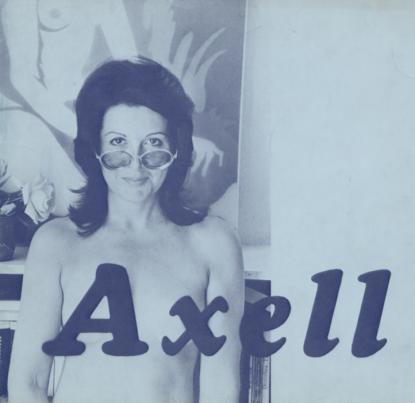
Born in the 30s and lived through the 60s
She studied pottery after high school then switched to drama, initially beginning a career as an actress. She married Jean Antoine, a film director who specialized in art documentaries for Belgian television…. Now, Axell was not her given name… her given name was Devaux. (father Andre Devaux)... She changed her name to Axell for acting career purposes. She worked as an interviewer in a documentary about avant garde artists, a television announcer, performed in a variety of theatrical and televised plays, and starred in several movies, one being the provocative Le Crocidile en peluche that she wrote herself.
Side note: she had a baby somewhere in between all of this. I have to make note of that because it’s a reminder of how magnificent women are…
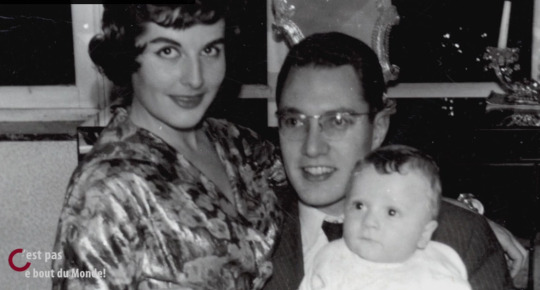
carrying on…
After some time she then quit her career as an actress and went on to pursue painting.
Not trying to be an encourage-er of quiters… but lets normalize this. Lets normalize changing directions when you are no longer fulfilled or satisfied with what you’re doing.
I’m assuming Evelyne had a strong desire to create, whatever it was she was supposed to be creating was a journey within itself she was trying to figure out… or maybe it was just about exploring… leaving no stone unturned.

So, apparently surrealist painter Rene Magritte, was a friend of her husband’s, and she was able to gain him as a mentor. They visited with each other 2 times a month over the course of a year and worked on developing and improving her oil painting technique.
Evelyne and her husband travelled a lot for work. On one of these trips she went to London with Antoine while he was putting together a production to spotlight pop artists. She met a few of these artists in their studios and became so influenced and enamored that she started to form her own style of Pop art, being one of the first Belgian artists to explore this style of painting.

She faced difficulties getting her paintings shown in galleries and in hopes of being taken more seriously as a female artist, she began using the androgenous name Axell professionally.
Like just Axell.. Period. And signing her paintings as Axell.
Her work is an intoxicating mix of art historical- and self-reference, formal originality, and a playful sense of political awareness. She was a protofeminist who was aware of the discrimination of women at that time and was mocking about certain things.

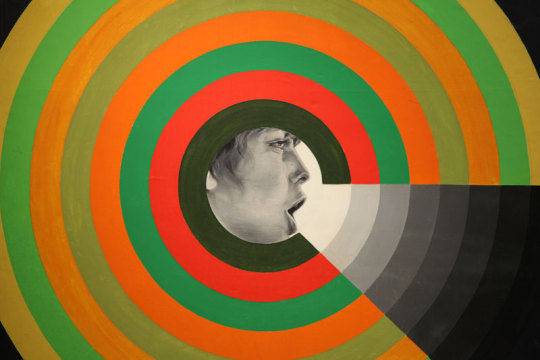
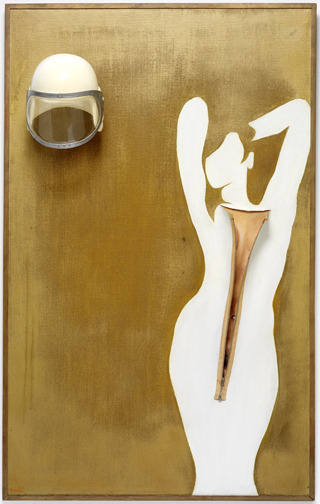
Her signature was the spherical blue glasses that she wore and often showed up in her artworks. She merged herself with a number of figures she depicted.

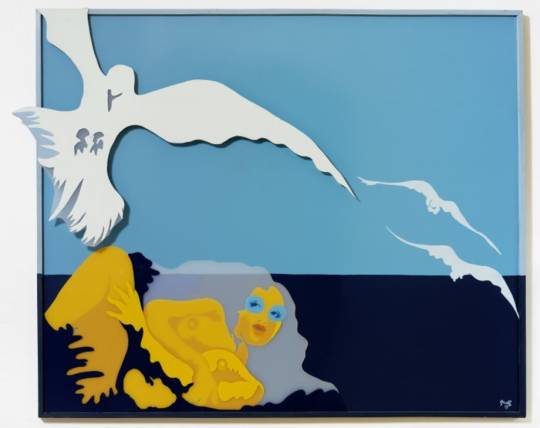
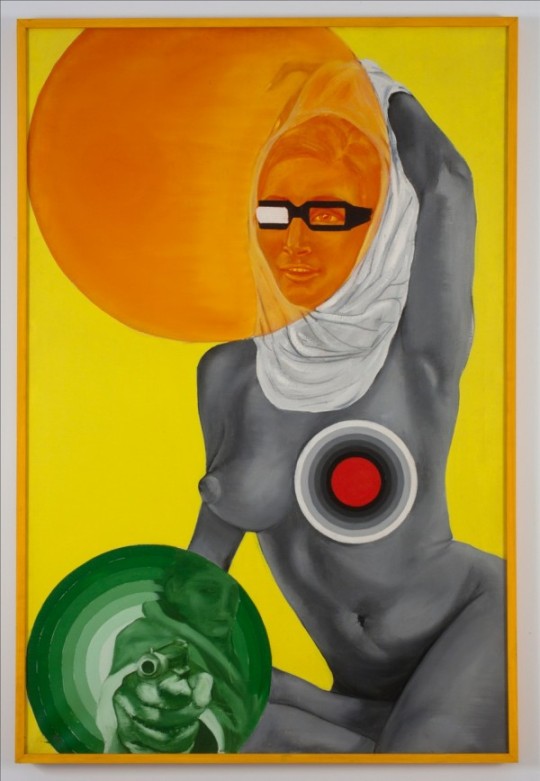
Her artwork speaks about the body and sensuality, about social limitations, taboos and their transgression in ways that invite the viewer to think outside the traditional borders of their social, political, or religious context. Axell's work is not just pioneering feminist art; it's the "outstanding quality" of it: her striking use of fresh, contemporary colors; her notable application of unusual materials, her surprising use of jutting layers to build highly original works that evade clear definition; and lastly, her refusal to be pinned in by art movements, be it pop or nouveau réalism, or even the surrealism of her one-time teacher Magritte, whose influence is apparent in her early work.
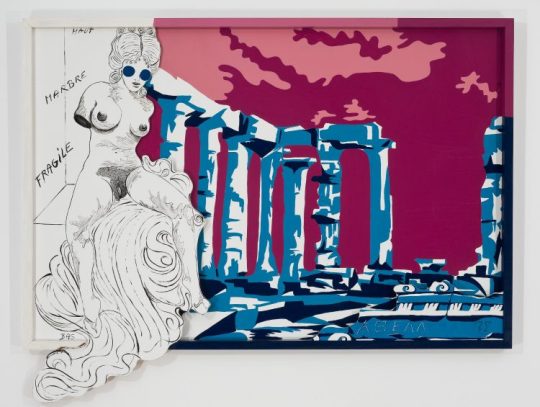

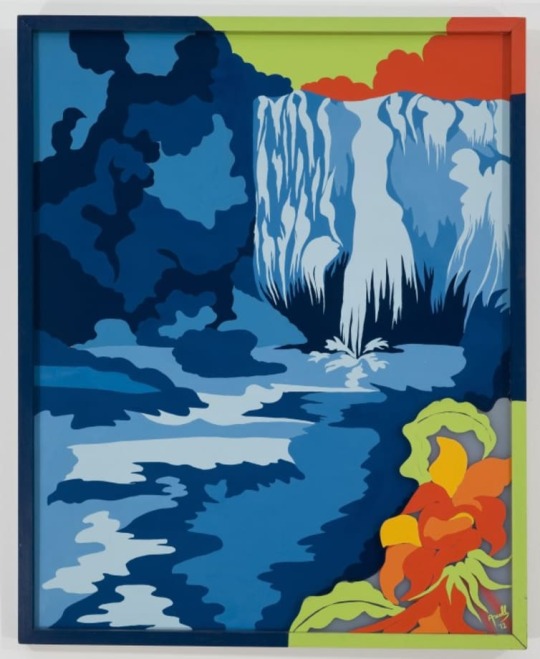
Axell's life was tragically cut short in a fatal accident outside of Ghent, Belgium, in September 1972. However, her legacy lives on, and her final piece, "L’herbe folle," is a testament to her creative brilliance. Axell's art continues to inspire and provoke conversation about social and political issues today.
Credits below:
#artist#artists on tumblr#artistsoninstagram#curatorial#curator#evelyne axell#axell#multimedia#pop art#contemporaryart#abstract art#women#feminist#representation
3 notes
·
View notes
Text

[entry no. 2]
I was given a data cache by an old Generation 083 Archivist, an early model that specialized in preserving the visual arts of humans. The conversation that led to that exchange was interesting on its own. We noted the serendipity that my work will eventually be the job of Archivists to care for in perpetuity. I wonder what generation they will be when I have finished.
There is a description for a work among these files:
Magritte's self⑇[ ]portrait shows him standing in front of low standing wall, in the background behind him disapᐙears[disappears] a hazy sea with clouds overhead. me[He] wears an overcoat and bowler hat of identical grey colors⟟["colours" or "," (spelling changed depending on culture, origin of file unknown)] contrasted⚶[ ]sharply by a bright red tie. Yet, the most prⲾminent[prominent] object is a green apple which2[ ]hovers, unsuppor𐓺ed[unsupported], in the air and obscures the man's face. Magritte commented "everything we see hides another thing, we always want to see what is hidden by what we see. There is an interest in that which is hidden and which the visible does not show us. This interest can take the form of a quite intense feeling, a sort of conflict, one might say, between the visible that is hidden and the visible that is present."
I was inspired to chronicle how we have progressed compared to those long ago times. The remark on being teased by what can be seen because its nature obstructs something else, which itself could be seen, but isn't: it is one archaic human sentiment which we are not able to relate to in the posthumanism era. Our senses are far more encompassing than those the human body had. Through the millennia we have attached new sensors and probes to our chassis which gives us an intuitive sense for each one's function. Our optical sensors find points of reflection in the materials' crystal lattices and we, without effort, compile them together to see the entire dimensional space of our surroundings. Already, this would break the concept of frustration this Magritte was trying to instill but I will expand further. We see ores and caverns through the earth, or anything to be precise, by firing ultrasonic waves into the stone and feeling the differences in how they return to us. It is useful for mining. We feel different wavelengths of radiation pass through us and can give a count of all the particles which have ever bounced off our exteriors. Even the future cannot hide things from us, as we calculate objects' travel vectors and have an innate understanding of where they will be at any given time. If the file which contains Magritte's actual work holds metadata that includes ray-penetrative data, and if Magritte was dutiful enough to actually render the face on the other side of the apple, I would see both the apple and the face at the same time through the layers of the work all the way down to the original plain surface below. Unfortunately, it seems the works' file I was given has been corrupted after all this time and thus obscures nearly the entire work as stated by the description.”
Entry credit to my friend Providence83.
Source image “Son of Man” by Rene Margritte
#digital art#artwork#artist on tumblr#art#artistsupport#art of the day#artist#procreate#artificial intelligence#art collection#apophis-ignotus#digital artist#graphic designer#unreality#dereality#graphic design#retro#picture of the day#vintage#posthumanism#dark futurism#posthuman era
9 notes
·
View notes
Text
Metaphysical
- This art movement began in 1910 and ended in 1920
-Movement was pioneered by Giorgio de Chirico when he was inspired by the experiences we have when we feel that we have moved away from time and our awareness of our surroundings becomes blurred, (daydreaming?).
-co-pioneered also by Carlo Carra as they worked together on this new style of painting.
-These painting aimed to depicted realistic imagery of contemporary settings with unusual juxtaposed iconography.
-These paintings allow the viewer to feel as though they are entering a dream.
- Metaphysical was not widespread to begin with due to Europe recovering from the horrors of World War I.
-These styles of works conveyed feelings of isolation and haunting mysteries.
-Fantasy world like paintings created by the imaginations of artists.
- Avant-garde movement in the early 20th century opposed the metaphysical art movement.
- subject matters consisted mainly of statues, mannequins, fish, mirrors, as well as geometrical shapes.
-a sense of ambiguity was created due to the feeling of escaping from reality and allowing yourself to see objects in ways absent of preconceived meaning.
- “paintings that which could not be seen”- Chirico.
-allusion that rests below the surface of the conscious mind.
-The metaphysical art movement influenced the Interwar Classicism movement.
Key Artists:
-Giorgio de Chirico
-Carlo Carra
-Giorgio Morandi
Concepts and Styles:
-De Chirico used many everyday objects such as; fish, statues, mannequins, mirrors, and architectural elements through juxtaposition in order to evoke feelings of ambiguity and uncertainty.
-many took inspiration from De Chirico’s iconography and began juxtaposing similar geometric forms within their paintings.
-Guillaume Apollinaire created metaphysical portraiture that was made up of juxtaposed objects that had psychological aspects as well as strange associations.
-metaphysical landscape paintings drew attention to Italian plazas and architecture. Many of these works depicted; modern elements, trains, factory smoke, high rise buildings seen through a window.
- the landscape works created an airy modern atmosphere, surrealist appearance and a sense of ambiguity.
After Metaphysical works:
-early 1920s in Italy Morandi, Carra and Sironi no longer made metaphysical artwork due to the popularity of the realism within the Novecento Italiano movement. Chirico moved to Paris and was influenced by classical masters and focused on realism to influence his work.
- De Chirico influenced surrealist artists Andre Breton, Max Ernst, Yves Tanguy, Rene Magritte, and Salvador Dali.
-Breton tried to encourage artists to continue or return to metaphysical work, as a result De Chirico at times returned to include elements of the metaphysical style within his works.
-De Chirico also influenced artist, George Grosz of the New Objectivity and Oskar Schlemmer of the Bauhaus. The were heavily influenced by Chirico’s mannequin imagery.
-metaphysical paintings influenced Italian architecture during the time between two world wars.
-Metaphysical influenced other art movements such as; Lettrism, Situationism, and Pop Art.


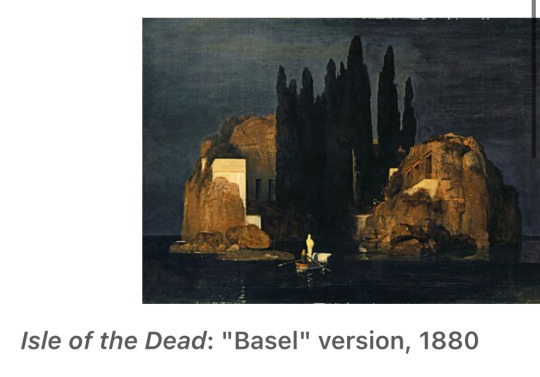
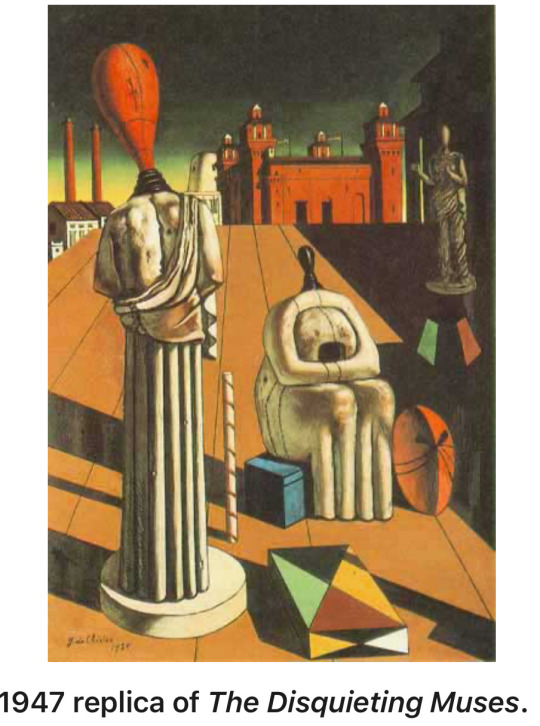
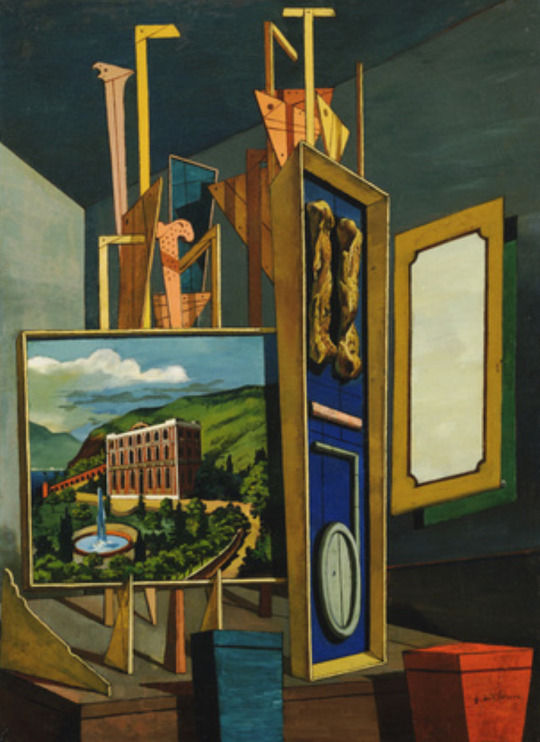
1917, Great Metaphysical Interior by Giorgio de Chirico.
How does this relate to my work?:
When painting my sinister characters I use my imagination or images I have seen when sleeping in order to create the faces of my sinister characters. It is as though I am entering my own pitch black world where I can see these face formulate in front of me. Once they have formulated enough in my head I automatically convey their imagery onto the canvas, not thinking too much about what they will look like. I almost allow the medium and my hand to do their own thing. My works have been more refined and soft in shape much like some of the shapes within surrealist and metaphysical paintings, however, I have been experimenting with a new technique that allows automatism to surface allowing my to have less control on the overall outcome of my paintings. There is a certain feelings of haunting, and discomforting ambiguity within my paintings much like many works seen within the metaphysical art movement. These images in my head are other worldly, I do not see them in my everyday life unless I force it in order to create my paintings. They are not images that the people around my can see unless the engage with my art.
0 notes
Text
John Baldessari Text Work
John Baldessari(June 17, 1931 - January 2, 2020) was an American conceptual artist known for his photography, print and collages using appropriated images. Born in National City, California, Baldessari attended San Diego State College where he began teaching following his BA. He taught for nearly 30 decades across universities and colleges in America. Baldessari grew up in isolation because of the Great Depression. Beginning as a painter, Baldessari began to incorporate text and photography into his canvases in the 60s. In 1970 he began working in printmaking, film, video, installation, sculpture and photography, creating work that demonstrates the narrative potential of images and the associative semiotic power of language.
Baldessari’s early text paintings featured painted statements from contemporary art theory on empty backgrounds, something he wasn’t happy about as the form and method conflicted with the use of language he preferred to use. He then removed his own hand from the piece, employing sign painters to add text to the canvases. In 1970, Baldessari and his friends burnt all the paintings he made between 1953 and 1966 to create a new piece, The Cremation Project. The ashes from the paintings were baked into cookies and placed in an urn that was depicted alongside a bronze plaque with each paintings birth and death dates. His text work also juxtaposes images of objects such as wood and the phrase “wood is wood” combined with “but a cigar is a good smoke” showing inspiration from Rene Magritte’s ‘The Treachery of Images’. In his inkjet print series ‘Double Bill’(2012), Baldessari paired the work of two artists, adding his own areas of colour and signing it as his own work alongside another chosen artist leaving the viewer to decode the collage of visual information. To make the viewer form connections, a lot of Baldessari’s work features pointing. Baldessari's ‘Commissioned Paintings’ (1969) series took the idea of pointing literally, after he read a criticism of conceptual art that claimed it was nothing more than pointing. Beginning with photos of a hand pointing at various objects, Baldessari then hired amateur yet technically adept artists to paint the pictures. He then added a caption "A painting by [painter's name]" to each finished painting resembling the actions of a choreographer rather than artist. Many of Baldesarri’s work features small sticker dots that cover faces of people in the images. These are called ‘Dot Portraits’. The dots evoke brightly coloured price tickets sometimes seen at garage sales. Baldessari has spoke about how he accidentally ‘levelled the playing field’ after using up some stickers he had.

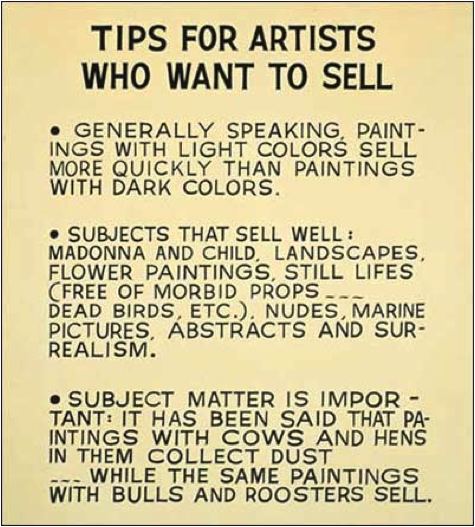

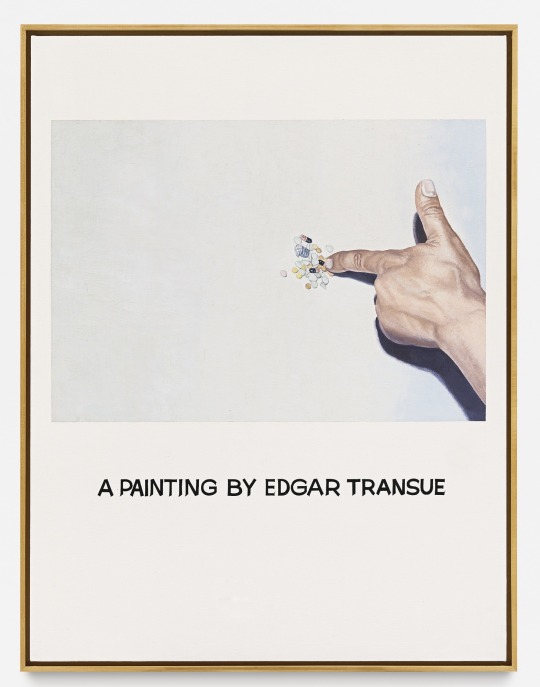
0 notes
Text
John Baldessari
John Baldessari(June 17, 1931 - January 2, 2020) was an American conceptual artist known for his photography, print and collages using appropriated images. Born in National City, California, Baldessari attended San Diego State College where he began teaching following his BA. He taught for nearly 30 decades across universities and colleges in America. Baldessari grew up in isolation because of the Great Depression. Beginning as a painter, Baldessari began to incorporate text and photography into his canvases in the 60s. In 1970 he began working in printmaking, film, video, installation, sculpture and photography, creating work that demonstrates the narrative potential of images and the associative semiotic power of language.
Baldessari’s early text paintings featured painted statements from contemporary art theory on empty backgrounds, something he wasn’t happy about as the form and method conflicted with the use of language he preferred to use. He then removed his own hand from the piece, employing sign painters to add text to the canvases. In 1970, Baldessari and his friends burnt all the paintings he made between 1953 and 1966 to create a new piece, The Cremation Project. The ashes from the paintings were baked into cookies and placed in an urn that was depicted alongside a bronze plaque with each paintings birth and death dates. His text work also juxtaposes images of objects such as wood and the phrase “wood is wood” combined with “but a cigar is a good smoke” showing inspiration from Rene Magritte’s ‘The Treachery of Images’. In his inkjet print series ‘Double Bill’(2012), Baldessari paired the work of two artists, adding his own areas of colour and signing it as his own work alongside another chosen artist leaving the viewer to decode the collage of visual information. To make the viewer form connections, a lot of Baldessari’s work features pointing. Baldessari's ‘Commissioned Paintings’ (1969) series took the idea of pointing literally, after he read a criticism of conceptual art that claimed it was nothing more than pointing. Beginning with photos of a hand pointing at various objects, Baldessari then hired amateur yet technically adept artists to paint the pictures. He then added a caption "A painting by [painter's name]" to each finished painting resembling the actions of a choreographer rather than artist. Many of Baldesarri’s work features small sticker dots that cover faces of people in the images. These are called ‘Dot Portraits’. The dots evoke brightly coloured price tickets sometimes seen at garage sales. Baldessari has spoke about how he accidentally ‘levelled the playing field’ after using up some stickers he had.
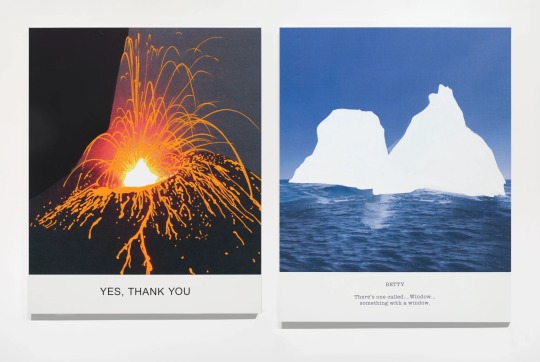

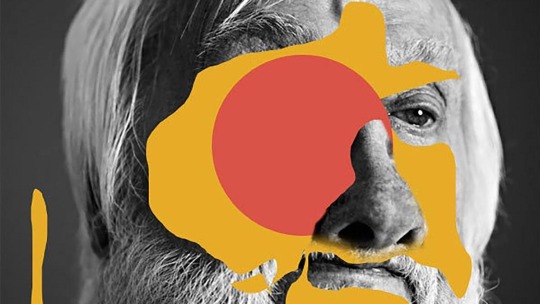

0 notes
Text
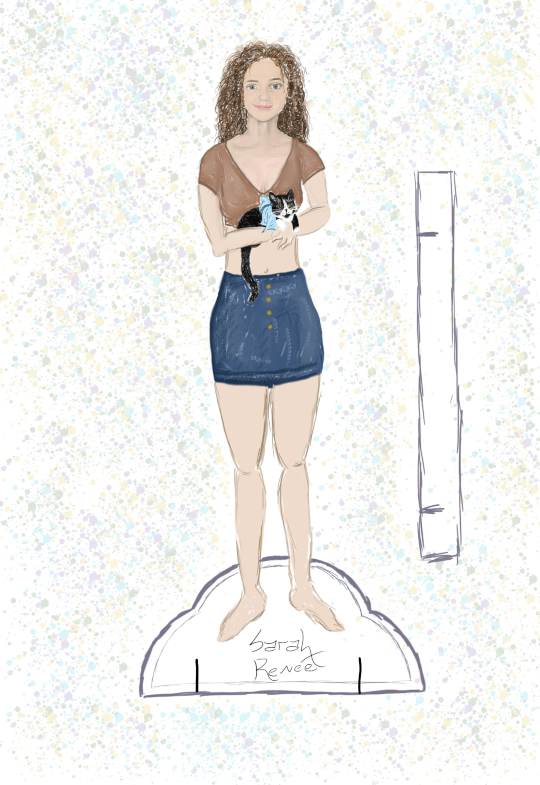
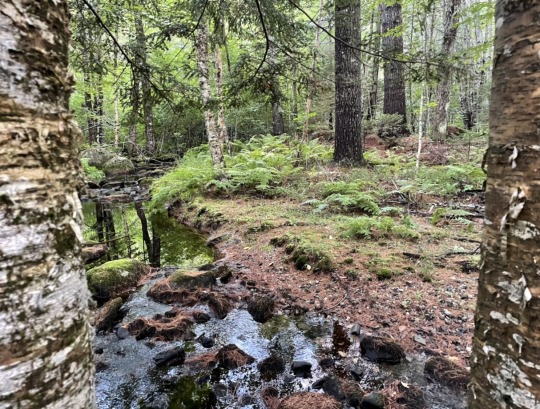

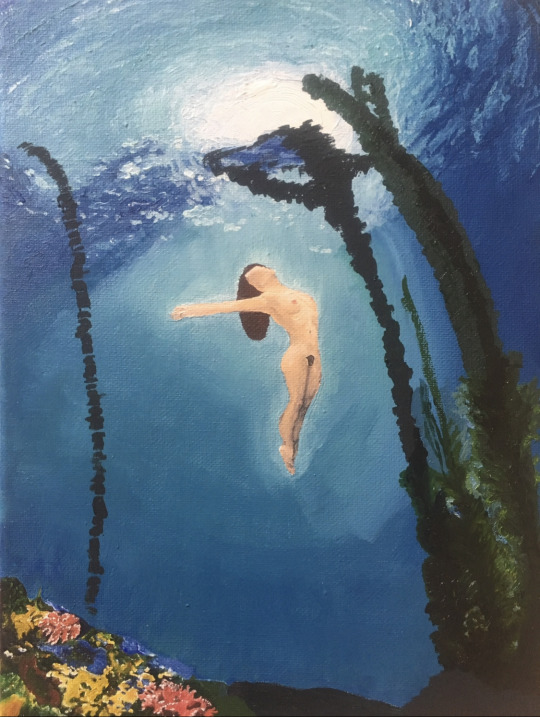

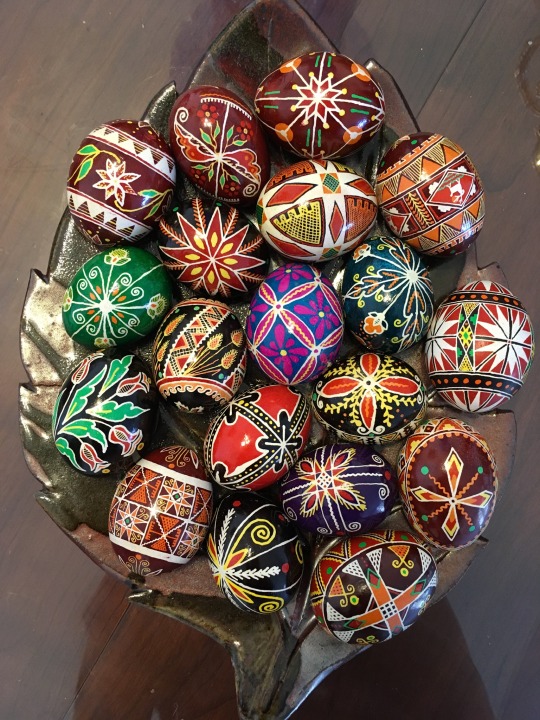

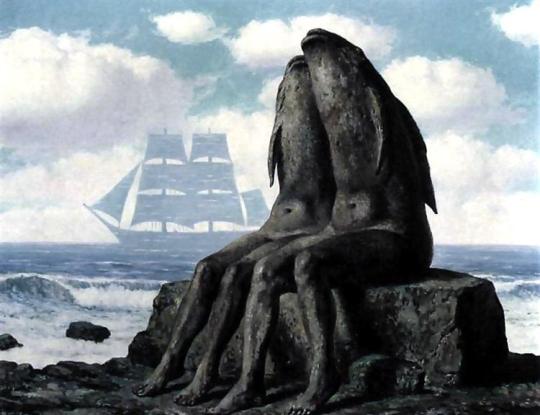
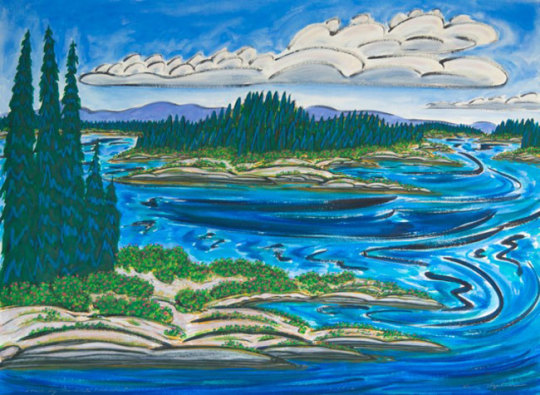
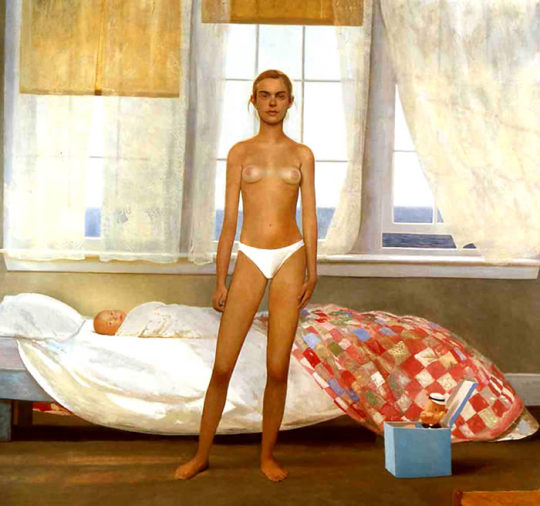

Sarah Renée Oźlański - Homework 01 - Tumblr Bio
I am Sarah Renée and was born and raised in the Midcoast region of Maine. I graduated high school early, and even though I wanted to go to art school, it wasn't an option for me at the time. So I worked on tall ships for over 10 years and lived all over the world including Nova Scotia, England, Ecuador, and every corner of the continental US. I am so happy to finally be putting down roots in Waldo Country again and very grateful to finally have the opportunity to study art and English at college. I am currently a second year student majoring in both Studio Art with a concentration in Painting and English with a concentration in Creative Writing.
Oil painting and pen and ink drawings are my favorite Western fine arts mediums (I included two of my current WIP). But I also love practicing the art that was passed down to me matrilineally from my Polish family of pisanki and embroidery. Pisanki is especially important to me, as it is a medium that bridges my two majors of Painting and Writing, since pisanki are written in a beautiful pictoral language. One of my goals as an artist is to portray my experience as a woman working on boats for ten years and to explore what it means to be female (or gender non-conforming) in traditionally masculine spaces and also to show feminine and non-binary gender expression in those spaces. For my self portrait I chose to make a paper doll, something I loved to play with as a child, because I like the world that something so simple opens up and the ease to try on new experiences.
Growing up in the Midcoast region I was fortunate to be able to make frequent trips to the Farnsworth Art Museum in Rockland. I grew up loving Louise Nevelson since I was child since she shares a similar Slavic heritage and Midcoast hometown. When I was a teen I discovered Erik Hopkin and Bo Bartlett. What I love about them is the way they depict the places and people I grew up with. Finally, Rene Magritte is my all-time favorite artist and surrealism is my favorite art movement. His painting "Song of Love" is my favorite because of the beautiful ship in the background and the unconventional way he depicts mermaids.
1 note
·
View note
Text
Rene Magritte - The robber (La Voleuse) 1927
Rene Magritte – The robber (La Voleuse) 1927
Rene Magritte – La Voleuse The robber1927
The robber – La Voleuse 1927 by René Magritte
René Magritte was a Belgian surrealist artist. René became well known for creating a number of witty and thought-provoking images. Often depicting ordinary objects in an unusual context, his work is known for challenging observers’ preconditioned perceptions of reality.
Magritte Rene Early works
Rene…

View On WordPress
#1900-1950#1927#analysis#Art#biography#death#La Voleuse#Paintings#Reckless Sleeper#René#Rene Magritte Early works#sleep#surrealism#symbolism#The robber
23 notes
·
View notes
Text
Illusion - research 1
23 January 2021
DADAISM
“Dada” is an avant-garde movement started in early 20th century in Zurich, Switzerland, in 1915, then in 1920 flourished in Paris. Dadaist artist wanted to show their discontent toward violence, war and nationalism by expressing nonsense, irrationality, and anti-bourgeois protest in their works. They wanted to shock establishment and share distrust to logic and their love to the absurd.
SURREALISM
Surrealism arose on the Dadaism. It is an artistic trend that begin in France in 1924 and initially appeared in the literature through the philosopher and poet André Breton. By assumption, this movement was to be an expression of rebellion against classicism, realism and what is rational, as well as the destruction of conventions in art. Through their paintings, the artists wanted to express their inner perception of reality in a way that is often grotesque, unreal, as if on the border of fantasy, reality and dream. Surrealism quickly spread around the globe and was represented by: Salvador Dalí, Jean Arp, Max Ernst, André Masson, René Magritte, Yves Tanguy, Pierre Roy, Paul Delvaux, Joan Miró, Toyen (Marie Cerminova), Frieda Kahlo. Surrealists looked their inspirations in philosophical theories by Sigmund Freud and Carl Gustav Jung as well as in symbolism of an earlier painters artists like Gustave Moreau, Hieronymus Bosch and Francisco Goya. Surrealists were fascinated by the human psyche and subconscious.

Salvador Dali (1904 – 1989) was a Spanish surrealist artist known for his technical skill, precise sketching and the striking and bizarre images in his work. He joined the Surrealist group in 1929 and became one of its leading representatives. A fellow of Man Ray.

Salvador Dali and Man Ray in 1934, Paris.

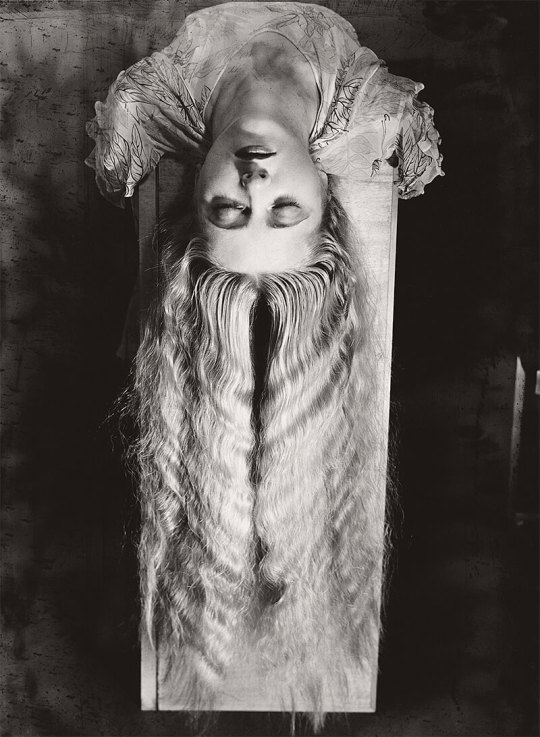
Man Ray (born Emmanuel Radnitzky; 1890-1976) was an American visual artist who spent most of his career in Paris. He was a significant contributor to the Dada and Surrealists movements. He considered himself as a painter, but he produced the most important works in various media. He was best known for his photography and was also an established fashion and portrait photographer. Man Ray is also known for his work with photograms, which he called "rayographs" in relation to himself.

Hieronimus Bosch (1450 – 1516) was a Dutch/Netherlandish painter from Brabant. His work, generally oil on oak wood, mainly contains fantastic illustrations of religious concepts and narratives. Within his lifetime his work was collected in the Netherlands, Austria, and Spain, and widely copied, especially his macabre and nightmarish depictions of hell.
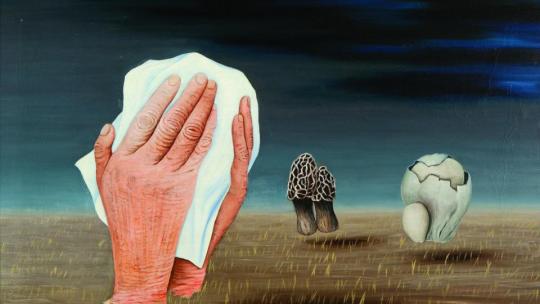
Toyen - Marie Čermínová (born in 1902, in Prague – died in 1980, in Paris), was a Czech painter, drafter, and illustrator and a member of the surrealist movement. She left the family home at sixteen. Toyen joined the Czech avant-garde Devětsil group in 1923 and exhibited with them. The group had strong international connections, especially but not only to French culture.
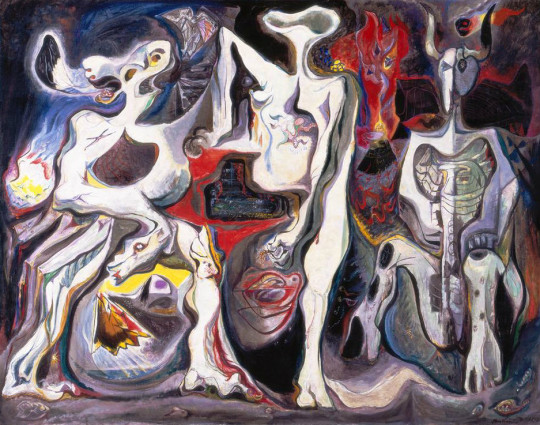
André Masson - André-Aimé-René Masson (1896 – 1987) was a French artist associated with surrealism, and he was one of the most enthusiastic employers of automatic drawing, making a number of automatic works in pen and ink.

Rene Magritte, René François Ghislain Magritte (1898-1967) was a Belgian surrealist artist. He created witty and thought-provoking images. He presented ordinary objects in an unusual context. His works are known for questioning the the perception of reality.

Dora Maar, real name - Henriette Theodora Markovitch (1907 – 1997), was a French photographer, painter, and poet. Pablo Picasso partner and his muse, she was depicted on many of his paintings.
17 notes
·
View notes
Photo

Philosophy of Art
The definition of art has been debated for centuries among philosophers.”What is art?” is the most basic question in the philosophy of aesthetics, which really means, “How do we determine what is defined as art?” This implies two subtexts: the essential nature of art, and its social importance (or lack of it). The definition of art has generally fallen into three categories: representation, expression, and form.
Art as Representation or Mimesis. Plato first developed the idea of art as “mimesis,” which, in Greek, means copying or imitation. For this reason, the primary meaning of art was, for centuries, defined as the representation or replication of something that is beautiful or meaningful. Until roughly the end of the eighteenth century, a work of art was valued on the basis of how faithfully it replicated its subject. This definition of "good art" has had a profound impact on modern and contemporary artists; as Gordon Graham writes, “It leads people to place a high value on very lifelike portraits such as those by the great masters—Michelangelo, Rubens, Velásquez, and so on—and to raise questions about the value of ‘modern’ art—the cubist distortions of Picasso, the surrealist figures of Jan Miro, the abstracts of Kandinsky or the ‘action’ paintings of Jackson Pollock.” While representational art still exists today, it is no longer the only measure of value.
Art as Expression of Emotional Content. Expression became important during the Romantic movement with artwork expressing a definite feeling, as in the sublime or dramatic. Audience response was important, for the artwork was intended to evoke an emotional response. This definition holds true today, as artists look to connect with and evoke responses from their viewers.
Art as Form. Immanuel Kant (1724–1804) was one of the most influential of the early theorists toward the end of the 18th century. He believed that art should not have a concept but should be judged only on its formal qualities because the content of a work of art is not of aesthetic interest. Formal qualities became particularly important when art became more abstract in the 20th century, and the principles of art and design (balance, rhythm, harmony, unity) were used to define and assess art.
Today, all three modes of definition come into play in determining what is art, and its value, depending on the artwork being assessed.
History of How Art Is Defined
According to H.W Janson, author of the classic art textbook, The History of Art, “...we cannot escape viewing works of art in the context of time and circumstance, whether past or present. How indeed could it be otherwise, so long as art is still being created all around us, opening our eyes almost daily to new experiences and thus forcing us to adjust our sights?”
Throughout the centuries in Western culture from the 11th century on through the end of the 17th century, the definition of art was anything done with skill as the result of knowledge and practice. This meant that artists honed their craft, learning to replicate their subjects skillfully. The epitome of this occurred during the Dutch Golden Age when artists were free to paint in all sorts of different genres and made a living off their art in the robust economic and cultural climate of 17th century Netherlands.
During the Romantic period of the 18th century, as a reaction to the Enlightenment and its emphasis on science, empirical evidence, and rational thought, art began to be described as not just being something done with skill, but something that was also created in the pursuit of beauty and to express the artist’s emotions. Nature was glorified, and spirituality and free expression were celebrated. Artists, themselves, achieved a level of notoriety and were often guests of the aristocracy.
The Avant-garde art movement began in the 1850s with the realism of Gustave Courbet. It was followed by other modern art movements such as cubism, futurism, and surrealism, in which the artist pushed the boundaries of ideas and creativity. These represented innovative approaches to art-making and the definition of what is art expanded to include the idea of the originality of vision.
The idea of originality in art persists, leading to ever more genres and manifestations of art, such as digital art, performance art, conceptual art, environmental art, electronic art, etc.
Quotes
There are as many ways to define art as there are people in the universe, and each definition is influenced by the unique perspective of that person, as well as by their own personality and character. For example:
Rene Magritte:
Art evokes the mystery without which the world would not exist.
Frank Lloyd Wright:
Art is a discovery and development of elementary principles of nature into beautiful forms suitable for human use.
Thomas Merton:
Art enables us to find ourselves and lose ourselves at the same time.
Pablo Picasso:
The purpose of art is washing the dust of daily life off our souls.
Lucius Annaeus Seneca:
All art is but imitation of nature.
Edgar Degas:
Art is not what you see, but what you make others see.
Jean Sibelius:
Art is the signature of civilizations.
Leo Tolstoy:
Art is a human activity consisting in this, that one man consciously, by means of certain external signs, hands-on to others feelings he has lived through, and that others are infected by these feelings and also experience them.
Conclusion
Today we consider the earliest symbolic scribblings of mankind to be art. As Chip Walter, of National Geographic, writes about these ancient paintings, “Their beauty whipsaws your sense of time. One moment you are anchored in the present, observing coolly. The next you are seeing the paintings as if all other art—all civilization—has yet to exist...creating a simple shape that stands for something else—a symbol, made by one mind, that can be shared with others—is obvious only after the fact. Even more than the cave art, these first concrete expressions of consciousness represent a leap from our animal past toward what we are today—a species awash in symbols, from the signs that guide your progress down the highway to the wedding ring on your finger and the icons on your iPhone.”
Archaeologist Nicholas Conard posited that the people who created these images “possessed minds as fully modern as ours and, like us, sought in ritual and myth answers to life’s mysteries, especially in the face of an uncertain world. Who governs the migration of the herds, grows the trees, shapes the moon, turns on the stars? Why must we die, and where do we go afterward? They wanted answers but they didn’t have any science-based explanations for the world around them.”
Art can be thought of as a symbol of what it means to be human, manifested in physical form for others to see and interpret. It can serve as a symbol for something that is tangible, or for a thought, an emotion, a feeling, or a concept. Through peaceful means, it can convey the full spectrum of the human experience. Perhaps that is why it is so important.
3 notes
·
View notes
Text
Ebook READ ONLINE Surrealism PDF DOWNLOAD
Ebook READ ONLINE Surrealism PDF DOWNLOAD
Surrealism
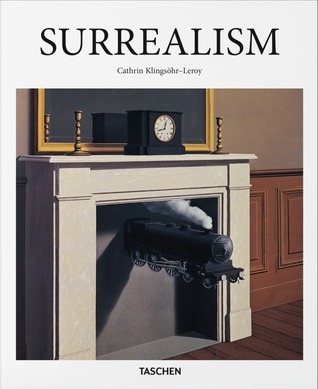
[PDF] Download Surrealism Ebook | READ ONLINEhttp://read.ebookcollection.space/?book=3836506734
Author : Cathrin Klingsohr-Leroy
Publisher : Taschen
ISBN : 3836506734
Publication Date : 2015-12-16
Language :
Pages : 96
To Download or Read this book, click link below:
http://read.ebookcollection.space/?book=3836506734
^#DOWNLOAD@PDF^#
Synopsis : Ebook READ ONLINE Surrealism PDF DOWNLOAD
Unleash the unconscious: Provoking the establishment with primal instincts WithSalvador Dalias its figurehead, the great ship of Surrealism traversed the turbulent seas of the early twentieth century with sails billowing withdreams and desires. Inspired by the psychoanalytical practice of Sigmund Freud, the Surrealists championed the unconscious as the domain oftruth, uninhibited by the standards or expectations of society.With techniques ranging fromhypnotismtonocturnal walkstoautomatic writing, the likes ofAndre Breton, Max Ernst, Brassai, andMeret Oppenheimproduced paintings, drawings, texts, and films in which they sought to excavate their most intimate and primal instincts. The results abound withsexual fantasies, withmysterious, menacing creatures, and with the juxtaposition of seemingly contradictory objects or ideas.This book introduces the origins and the sensational legacy of the Surrealist movement, one of the mostprofound and enduring influences on film, theatre, literature, art, and thought.Featured artists: Hans Arp, Andre Breton, Giorgio de Chirico, Salvador Dali, Max Ernst, Alberto Giacometti, Paul Klee, Rene Magritte, Andre Masson, Matta, Joan Miro, Pablo Picasso, Meret Oppenheim, Yves Tanguy About the Series: Each book in TASCHEN's Basic Genre series features: a detailed illustrated introduction plus a timeline of the most important political, cultural and social events that took place during that period a selection of the most important works of the epoch, each of which is presented on a 2-page spread with a full-page image and with an interpretation of the respective work, plus a portrait and brief biography of the artist approximately 100 colour illustrations with explanatory captions '
2 notes
·
View notes
Text
i try to analyze tableau vivant in popular culture and fail miserably
Hello and welcome to me suffering, in 4k.
This week we focused on a hefty little thing (a big big thing that is probably one of the most important parts of a film, if not the most important) called mise-en-scene. According to our lecture slides, it was first applied to the practice of directing plays then used to signify a director’s control over what is present within the film frame. It is the arrangement of props, lights, actors, etc. Also, mise-en-scene is also something that we use to analyze a work.
Now, how do we use it in the context of tableau vivant? Well, first I should probably figure out what a tableau vivant is.
To simply put it, tableau vivant is a living painting. In the context of movies and pictures, the actors mimic a painting and its mise-en-scene in the mentioned mediums.
When I looked up examples, I realized the pictures that come up are mostly homemade recreations of paintings and, it occurred to me that all the Turkish people who went to high school between the years 2015-2019, have been in a tableau vivant. You see, we had this challenge where students recreated famous paintings within their class and everyone did the same paintings over and over again but, in my opinion, it is still something .
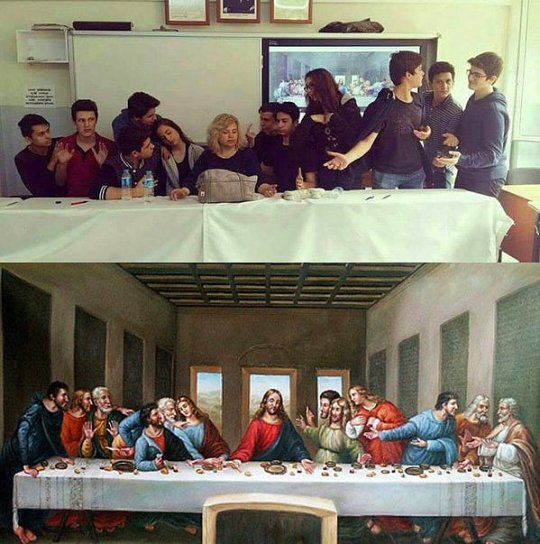
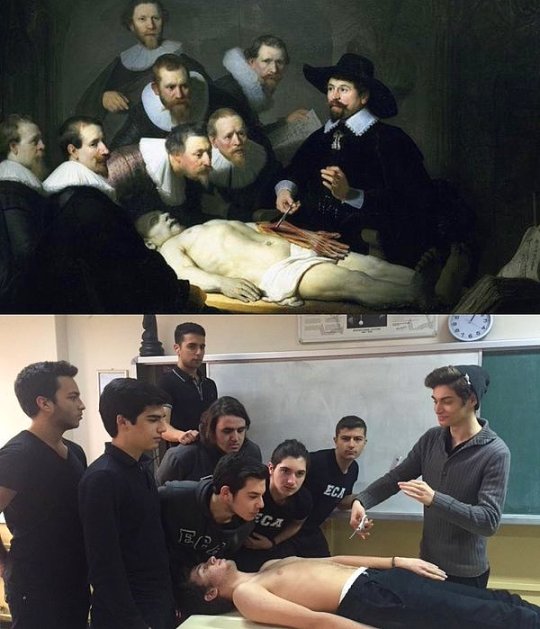
I did not attend high school enough to be in one of these so, I won’t talk about it anymore thank you.
Bonus: The most obvious example, Ariana Grande God is a Woman ,
several paintings and sculptures are recreated in the form of tableau vivant.
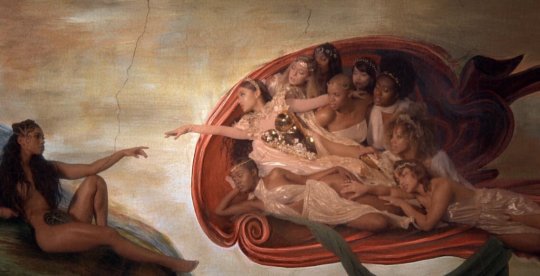

Tableau vivant within film is hard to get it right. It requires extreme attention to detail and a great vision to fit into the overall theme of the film. If I’m not wrong most of Wes Anderson’s work functions like tableau vivant. He has the eye for it and his mise-en-scene is more reminiscent of paintings than real life. Due to my ADHD, I simply cannot sit through an entire film anymore so I did not pile up on any Wes Anderson references.. And I’m sorry if the examples I came up with are too outdated, overused or, simply irrelevant.
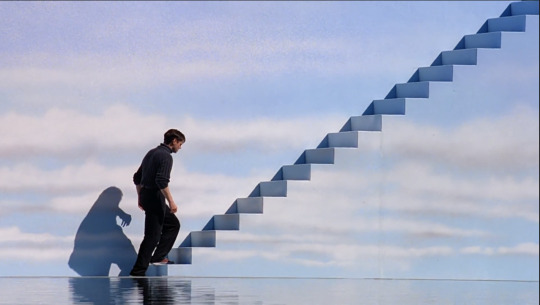
When we first started talking about tableau vivant, all I could think about was the ending scene of the Truman Show. I knew the scene was inspired from a painting but I could not remember what it was but, while I was researching I came across the painting and it finally clicked.
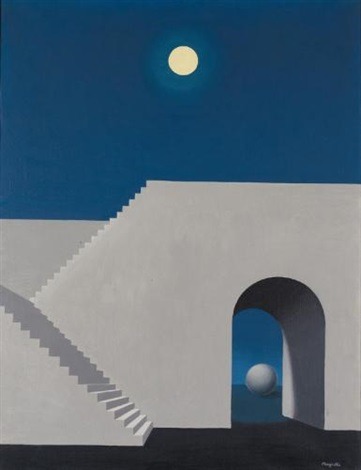
Rene Magritte’s Architecture Au Clair De Luna, was not as similar as I remembered it but, I think this makes more sense than what I had in mind.
The moon is flat but, illuminates the architectural elements of the painting quite well. The architecture within the painting stands out without having a central focus and I think it gives it a mysterious atmosphere feeling outer-worldly. Also, the arc and the first flight of stairs create a 3-dimensional feeling but the overall image feels oddly flat. The lighting is too white to be natural almost like the moon is not actually supplying it, and the way light falls on top of the sphere and the stairs feel natural but, the color of the light and the 2 dimensional part is not.
When I put it that way the scene perfectly captures the eerie feeling of the painting. Because this is where Truman frees himself from the world he once believed to be real and the way clouds are 2-dimensional supports the idea. Truman’s world was once 2-dimensional as well but even though we don’t see him after he goes through the door/the arc we know he’s going to step into the real world (you know 3-dimensional like in the arc in the painting).
The scene also reminded me of La Reconnaissance Infinie (The Infinite Recognition) but, it's probably because of the clouds that I feel that way.
Even though, Paul Colinet talked about the painting as, ‘The subject of this painting is the Moon. What we have to do is find something that really makes us feel we are on a spherical world. If the moon illuminates a scene, it mustn’t be ranked as an indifferent spectator or a mere go-between, or simply have a picturesque role. A trap for the moon, an incantation, a lunar mirror – these give a slight idea of the sort of thing we should be looking for.’ (Sarah Whitfield, Magritte, The South Bank Centre, 1992). Which oddly fits with The Truman show when we look into it.

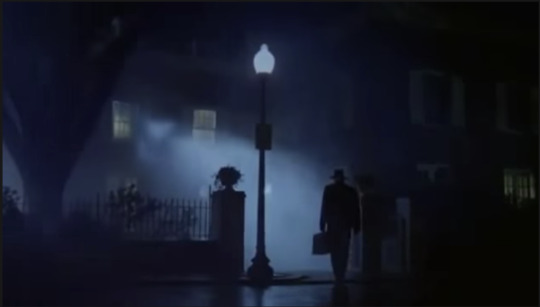
I also want to talk about another film (I swear it's going to be short). I really like Rene Magritte’s work and as I was writing it occurred to me that the scene that the priest arrives is oddly similar to his The Empire of the Light painting.
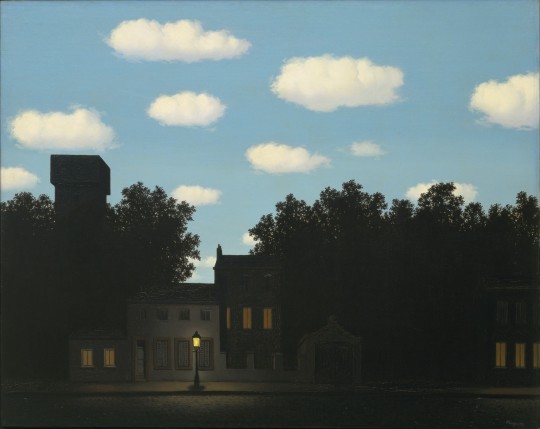
I ran a few blocks and videos to see if it was included and yes, yes it is. The imagery of the light is used to create an atmosphere both in the painting and the film. Even the placement of the lamp is similar. The mise-en-scene of the painting is protected in the scene (other than the blue tint but I think it adds to it).
Bonus: again the most obvious example, Girl with the pearl earring, it's even in the title, genius I know.
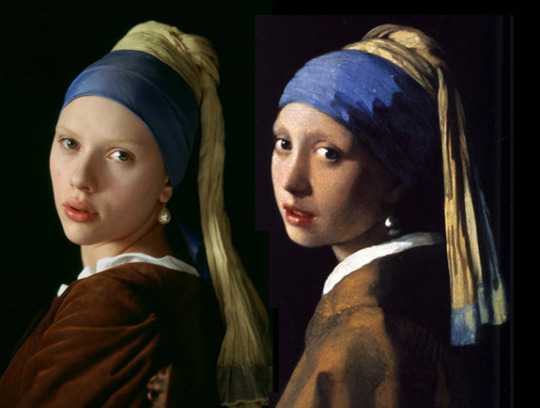
With this, my attempt at analyzing tableau vivant is over and, this is the first time I didn’t go over thousand words, hooray !
Now, If you excuse me I have to go to bed and, wake up early to go get the tray of brownies I accidentally bought. Cheers.
4 notes
·
View notes
Text
Notes from the Story of Modern Art
Modern Art period – 1860s to the 1970’s
Term associated with the conscious break of art traditions in the spirit of experimentation demonstrated through the use of radical approaches to composition, materials & imagery.
Influencing Factors – pre 1850s
The scientific revolution (16th – 18th Centuries) – began to question the certainties in religion that had been the pillars of communities & cultures.
Age of Enlightenment (18th Century) – the idea that people can think and reason for themselves, rather than following suite to religious teachings. Age of philosophers like Voltaire.
Age of Reflection or Romanticism (19th Century) – Understood as a reaction to the rational & scientific understanding of the world. Placing importance on the individual & emotional experience in the world.
Social Changes of the 19th Century
Urbanization, more people moving to the city. Societal structure change and in the invention of a middle class. Increased travel, more seeing of the world & cultures than ever before.
Scientific factors (19th -20th Centuries)
Photography – changing how we see the world. Why try paint realistically when a photograph can do a better job?
Telecommunication – phone, radio, cinema – changing how we communicate and interact.
Pre Modern Art (1860-80)
Impressionism – Renoir, Manet, Mary Cassatt, Money, Pissaro, Degas
Reflecting the changing qualities of light & movement – open loose brush strokes, using everyday subject matter,
Post-impressionism – Van Gogh, Seurat, Toulouse-Lautrec, Monet, Cezanne, Degas, Gaugin
Reacting against naturalism of impressionism exploring colour, line, form & emotional response. Led to development of expressionism.
The Pioneering Early / Emerging Modernists (1900-1910)
Fauvism – Henri Matisse, Andre Derain
Thrived in Paris 1905. Vividly expressionistic & non-naturalistic use of colour. Matisse regarded as the movements leading figure. Important influence on subsequent artists.
Expressionism
Edvard Munch, Kandinsky, Paul Klee, Franz Marc, Egon Schiele, Ernst Ludwig Kircher
Presenting from a subject perspective. Distorting images for an emotional impact.
Early Abstraction (1900s-1920s)
Cubism
Picasso
Exploration of forms & perspective. Use of simplified geometric shapes, and later collage.
Suprematism/ Constructivism (Russia)
Kasimir Malevich, El Lissitzy, Naum Gabo, Vladimir Tatlin, Alexander Rodchenko, Piet Mondrian (De Stijl Holland)
Geometrical shapes associated with the idea of spiritual purity reflecting modern industrial society & the urban.
Dada
Marcel Duchamp, Hugo Ball, Hannah Hoch, Kurt Schwitters
Formed during WW1 in Zurich as a result of the horrors of war. Including art, poetry & performance often mocking and nonsensical.
Surrealism (1920-40)
Max Ernst, DiChirico, Man Ray, Rene Magritte, Salvador Dali
Cultural movement developed after WW1 and largely influenced by Dada. Visual works, writings & juxtaposition of forms and realities to active the unconscious mind through imagery.
Abstract Expressionism (1940s-1960s)
Jackson Pollock, Barnett Newman, Mark Rothko, Willem de Kooning, Lee Krasner, Helen Frankenthaler, Franz Kline
Development of abstract art originating in New York. Focusing on emotional expression & spontaneous creativity. Large gestural expressive paintings lacking in imagery. Action Painting.
Pop Art (1950-60)
Andy Warhol, Jasper Johns, Robert Rauchenberg, Roy Lichtenstein, Claes Oldernberg, Peter Blake, David Hockney Richard Hamilton
UK & USA. Challenging the traditions of fine art including images from popular culture and mass production.
Minimalism (1960s-1970s)
Joseph Kosuth, Donald Judd, Frank Stella, Carl Andre, Eva Hesse, Richard Serra, Walter de Maria
Extension of abstract art and the idea that art should have its own reality and not be an imitation of something else.
Conceptual Art (1960s-1980s)
Marcel Duchamp, Joseph Kosuth, Sol leWitt, Yoko Ono, John Baldessari, Joseph Beauys, Jenny Holzer, Barbara Kruger, Richard Long, Robert Smithson
Referred to as conceptualism – the idea involved in the work took precedence of the aesthetic. The idea would be at the heart of work, often included everyday works/text.
Postmodernism (1970s/1980s onwards)
Jeff Koons, Cindy Sherman, Barbara Kruger, Damien Hirst, Tracy Emin, Gerhard Richter, Marina Abramovic, Christo, Julian Schnabel, Jean Michel Basquiat, Gerog Baselitz
Sought to contradict some aspects of modernism. Intermedia, installation art, conceptual art & multimedia. Art made between the turn of the 1960s and turn of the 20th Century. Ironical & playful treatment of subjects breaking down of culture hierarchies. Authenticity, originality with an emphasis on image & spectacle.
2 notes
·
View notes
Text
essay on yve’s tang and rene magritte (W.I.P draft)
The artist I have chosen that really does inspire my work is the French born artist Yves Tanguy who was a surrealist painter who was and is well known for his abstract landscape pieces that just make me happy looking at? He has a very unique style of painting which was unusual for the time and was completely different from other surrealist art at the time. Yves didn’t start off wanting to do art, like most of us he kind of floated around in life not knowing what to do, he joined the navy in 1918 and afterword’s into he took up jobs until he came by a painting by the artist Giorgio de Chirico and was deeply inspired by It and was inspired to become an artist due to it. He got right away to painting, fully being absorbed right into it like it was his calling he was waiting for. He would only work on one piece at a time which could probably be due to how small of a studio he had at a time which would only have enough room to work on one piece. He was introduced to the surrealism style by his friend prevert showing him the work of many surrealism artists who revolved around André Breton.
His style is very unique and distinct, a far departure for what other surrealist artists were doing at the time, his pieces show off mostly empty vast landscapes that are mostly occupied by nonsensical objects that maybe act as a metaphor for the brain. The brain is normally shown to be a calm desert so maybe these objects represent thoughts? He uses a very limited colour palette in his pieces, mostly consisting of normal colours for the sky and sand but more unnatural colours are used for the abstract objects so they stand out way more than the desert its self. Due to these colours, they stand out way more which is good as the abstract shapes tend to be either small in the background or super close in your face with the angels he paints. He either paints his objects as very loose, fabric like making them look like draped cloth and in contrast he paints a lot of objects also that are ridged with very strong looking structures that make them appear almost like concrete or clay. What he does with these shapes is very unusual, with his cloth like shapes he tends to make them either bend in the non-wind almost like they’re stretching to the heavens and with the ridged shapes he tends to leave them as is most of the time which helps contrast form between the both of them.
The colour in his pieces is also placed oddly too, most of the time there’s one colour almost bleeding into another, for example: in the piece Through Birds, Through Fire, But Not Through Glass 1943 he tends to make the orange red in the highest top object slowly shift into a bright yellow which is just subtle enough that you don’t notice on first glance but really start picking it up when you look closely. He tends to go for very heavy shadows, not adding much in the ways of transitioning into the darker parts of the shadows, he literally just tends to block in a thick layer of black to empathise his shadows which allows them to appear almost like a second object in itself. He paints a lot of sky’s in his backgrounds, I’ve noticed he really tends to like painting in fluffy light clouds or either a very slight fog which you also might miss on first glance but they help create both a calm relaxing atmosphere for his pieces but also a mysterious type of ambiance like anything could be hidden in that fog. I’ve just noticed he goes with the three main colours way of kind of selecting a colour palette, for example in one piece he will use faint blues, yellows and reds are his three main colours which has been a common reoccurring element in his pieces. Some of the objects he paints will sometimes not follow the laws of gravity and just float, this really helps further the dream motive of his pieces, almost like these objects are floating off into the white abyss above almost like a passing memory. Another thing that also helps with the motive of these objects trying to reach the great above are the objects that are the objects that seem to have a ton of blob like webs that almost look like they’re climbing up the structures and assembling into their own version of that object.
Another surrealism artist that I like is Belgian born artist rene Magritte. Rene was a surrealist artist who was mostly known for his lighter more humorous pieces but also his more down to earth pieces which helped people think on issues and often depicted regular objects in strange areas. Rene has had a harsh life, when he was 14 his mother committed suicide by drowning herself in the river, this wasn’t the first time she attempted suicide. His early paintings which where around 1915 where in an impressionistic style, a style which was characterised by thin, small yet visible brushstrokes which often showed off a normal subject matter which is of course a huge polar opposite for what surrealism is and is what surrealism is agents. He moved from movement to movement a lot, going for more abstract movements with each change like, impressionism to futurism to cubism to then finally settling on surrealism which was the most abstract of them all. He starts surrealism painting when in 1922 he saw the reproduction of the painting “the song of love 1914) which brought rene to tears, he stated this was “one of the most moving moments of my life: my eyes saw for the first time”.
He paints a lot of surrealistic stuff, he’s mostly well known for the portraits he would do with the objects covering a person’s face; however, he also created a lot of lesser-known abstract landscapes which often depict a lot of nature. He uses a lot of blue greens and browns to create a very earth like piece, he uses a lot of earth like imagery in his work which creates a much more intense dream like feel with his use of the vivid blue sky and soft fluffy clouds. He tends to focus on one main subject when he’s painting his surrealistic pieces, for example his most famous piece a man’s face being covered with an apple or a Boquete of flowers that’s ends are actually a bunch of old-fashioned pipes. With his pieces of people with they’re faces covered it might be referring to the fact that the brain cannot make up peoples faces when dreaming, we always have to see someone even for a second to see them in a dream so these pieces could maybe represent the unconscious brain trying to make up a face on its own. He uses a lot of clouds in his pieces to further the dream motive, they help his pieces also look a lot calmer despite all of the abstract pieces in his paintings.
He tends not to add a lot of visible brushstrokes to his pieces, he opts to make pieces with thick well blended paint to go for a more realistic feel to contrast the abstract with the more realistic style of painting he goes for. The brushstrokes that he makes visible is to add texture to objects like rougher brushstrokes for bricks and lighter drier brushstrokes to help empathise the fluffy clouds he’s going for and even drier brushstrokes to help empathise the dry dirt and sand he paints. He’s very hyper detailed with how he paints, even for most realism artists he really pushes himself, for example he adds the tiniest of bumps and cracks in order to make a huge rock painting and the tiniest pieces of disturbed sand in one of his landscape pieces to add just that little more life to his work.
Comparing both yve’s and Rene’s work, Rene is the more realistic painter of them both, Rene opts for more minor details like details in the sand he paints where yve goes for a smoother look to his piece which makes his shapes more abstract but sacrifice detail. Rene also has a more verity to what he paints as he doesn’t just paint one thing like yve does, however, yve doesn’t really need much verity to his work as his unique trait really is that he paints mostly the same subject over and over again. There’s a lot more visible brushstrokes in yve’s work, he uses it a lot in the sand to add contrasting colours in it and he also uses it in his more fabric-based shapes to add a fabric like texture to them. Rene’s use of brushstrokes is a lot looser in application to Yves, but he makes them count, only adding them to the objects that could use the extra layer of detail like his use of sand and fabric. They both go for I believe the representation of the subconscious mind, yve’s with the thoughts in our mind and the passing emotions and Rene with representations of dreams and showing how bizarre they really can be.
In conclusion, I very much prefer yve’s more simplistic surrealism, I just find it a bit more unusual where I feel like Rene’s just makes a bit too much sense for my liking, I prefer work when its at its weirdest and yve hits that spot. I also very much prefer the palette Yve uses as it’s much more muted palette which despite being very muted makes the strange objects he paint all blend into one giant mess of abstractness that just makes my eyes happy to look at.
1 note
·
View note